Caryn
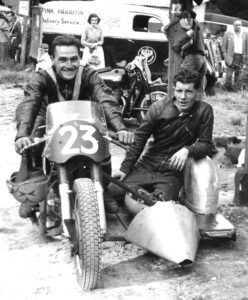 As long as there have been vehicles, there have been people who felt the need to race them. Enter Sidecar Racing. Like all forms of racing, Sidecar Racing began with started with vehicles built for the street. They were a simple motorcycle with a simple sidecar attachment. Over the years, however, the sidecars have evolved to increase speed and safety.
As long as there have been vehicles, there have been people who felt the need to race them. Enter Sidecar Racing. Like all forms of racing, Sidecar Racing began with started with vehicles built for the street. They were a simple motorcycle with a simple sidecar attachment. Over the years, however, the sidecars have evolved to increase speed and safety.
`
The early modifications were to lower the center of gravity by laying the driver forward over the engine. This modification reminds me of the Ninja motorcycle, otherwise known as the crotch rocket. It inspires speed in the vehicle. The sidecar itself was also changed from a mere basket to a platform, so that the passenger or monkey, could be mobile. Having a mobile passenger meant a moveable mass to help keep the tires on the ground at higher speeds. The passenger could lean this way and that to help stabilize the motorcycle and sidecar. As with any vehicle, the basic motorcycle components were used to build the racer…engine, steering, and larger diameter treaded tires. The racer was void of anything that could get in the way of aerodynamics. All that was there were fenders and whatever the driver and passenger could provide. Oddly, this type of sidecar, original around 1949, is still raced today in vintage classes, and most are home built.
Nevertheless, the vintage class has given way to the modern class, and after years of modifications and updates and the modern sidecar has emerged. Even today, some of the modern sidecars are home-built, but there are also companies who are dedicated to building sidecars. Whereas the home-built sidecars tend to be 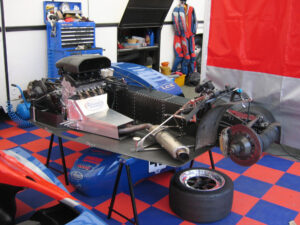 made of steel tubing and are less refined, the specialized companies use aluminum, carbon fiber, or other types of stronger, lighter material, designed to make the vehicle even faster. These specialized shops are also able to build a vehicle with a better suspension and better handling, as well as single swing arms for ease of wheel change. The modern sidecars use slick tires, as opposed to the larger diameter treaded tires. Race cars made the slick tires “famous” for their ability to build speed before takeoff. They also have molded aerodynamic bodies, probably much better than the home-built models, at least as far as speed is concerned.
made of steel tubing and are less refined, the specialized companies use aluminum, carbon fiber, or other types of stronger, lighter material, designed to make the vehicle even faster. These specialized shops are also able to build a vehicle with a better suspension and better handling, as well as single swing arms for ease of wheel change. The modern sidecars use slick tires, as opposed to the larger diameter treaded tires. Race cars made the slick tires “famous” for their ability to build speed before takeoff. They also have molded aerodynamic bodies, probably much better than the home-built models, at least as far as speed is concerned.
These days, there are three types of modern sidecars. Known as F1 (Formula 1), F2 (Formula 2), and F3 (Formula 3), with the F2 and F3 sidecars having the motors positioned under the drivers. Oddly, for full out speed, the best choice is the F1 model sidecar. I guess that placing the driver on top of the engine wasn’t the best modification for speed. The F1 models are sometimes referred to as long bikes. The motor on the F1 is behind the driver. The maximum engine displacement in this category is 1000cc 4 stroke. For the F2, the maximum engine displacement is 600cc 4 stroke or 500 cc 2 stroke. Engines are pre-1996 for F3. The F2 and F3 sidecars have a shorter wheelbase than the F1. This gives them better handling on short tracks, so 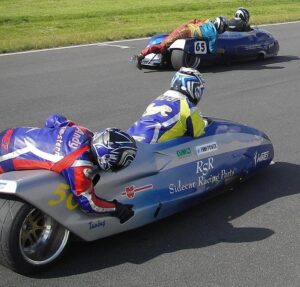 apparently the racer needs to know what model will fill the need for the track being raced. Whichever class the racer choses, the sidecar wheel will not have any suspension. The engines can be carbureted, or fuel injected. One hard and fast rule is that they must also be chain or belt drive, because shaft drive engines are allowed. Other than these many changes, the basic design is the same as the vintage sidecar racers. Obviously, if the sidecar were placed anywhere else, it would not be a sidecar. The sidecar racers usually run between $6,000 to $20,000 and will last for several years…probably a bargain considering the amount of money that goes into most race vehicles.
apparently the racer needs to know what model will fill the need for the track being raced. Whichever class the racer choses, the sidecar wheel will not have any suspension. The engines can be carbureted, or fuel injected. One hard and fast rule is that they must also be chain or belt drive, because shaft drive engines are allowed. Other than these many changes, the basic design is the same as the vintage sidecar racers. Obviously, if the sidecar were placed anywhere else, it would not be a sidecar. The sidecar racers usually run between $6,000 to $20,000 and will last for several years…probably a bargain considering the amount of money that goes into most race vehicles.
FIM (International Motorcycling Federation) Sidecar World Championship is the international sidecar racing championship. It is the only remaining original FIM road racing championship class that started in 1949.
 Many people have heard about the 1970 plane crash that killed the Marshall University football team, but what many people may not know is that the Marshall University crash was not the only crash that year, or even the first crash involving a football team. The first one involved the Wichita Stake Shockers football team. On Friday, October 2, 1970, at 1:14pm, in clear and calm weather, with amazing visibility, the Wichita State chartered 4-0-4 airliner crashed into a mountain peak just eight miles west of Silver Plume in Colorado. The plane, operated by Golden Eagle Aviation, the twin-engined propliner carried 37 passengers and a crew of three. Of those onboard, 29 were killed at the scene and two later died of their injuries at the hospital.
Many people have heard about the 1970 plane crash that killed the Marshall University football team, but what many people may not know is that the Marshall University crash was not the only crash that year, or even the first crash involving a football team. The first one involved the Wichita Stake Shockers football team. On Friday, October 2, 1970, at 1:14pm, in clear and calm weather, with amazing visibility, the Wichita State chartered 4-0-4 airliner crashed into a mountain peak just eight miles west of Silver Plume in Colorado. The plane, operated by Golden Eagle Aviation, the twin-engined propliner carried 37 passengers and a crew of three. Of those onboard, 29 were killed at the scene and two later died of their injuries at the hospital.
The plane was one of two 4-0-4 airliners flying the team to Logan, Utah. Three months earlier Wichita State had contracted Golden Eagle Aviation to supply a Douglas DC-6B, to fly the team to away games for the 1970 season. The four-engined DC-6 was a large, powerful aircraft that could accommodate the entire team in one plane. At the time of the contract, Golden Eagle Aviation did not own the DC-6. Nevertheless, they had made an arrangement with the Jack Richards Aircraft Company to use theirs. Unfortunately, after the agreements were made, the Jack Richards Aircraft Company DC-6 was damaged in a windstorm, so at the last minute it was unavailable for use. The two Martin 4-0-4s, hadn’t flown since 1967, so thy were quickly re-certified for flight. While it might seem like that could have been the cause of the crash, it was not. On October 2, 1970, the two 4-0-4s were ferried from the Jack Richards Aircraft Company facilities in Oklahoma City to Wichita, instead of the expected DC-6. The 4-0-4s were smaller planes, and so the team had to be split into two groups. Upon arrival in Wichita, the two aircraft were loaded with luggage and the passengers were boarded. The planes then headed west to a refueling stopover in Denver at Stapleton Airport. From Denver, they would continue to Logan Airport in northern Utah. The two planes were dubbed “Gold” and “Black” after the school colors. “Gold” was the aircraft that later crashed. It carried the starting players, head coach, and athletic director, as well as their wives, other administrators, boosters, and family. The “Black” plane transported the reserve players, assistant coaches, and other support personnel, and it took the normal route from Denver to Logan, going by way of the original flight plan and took a more northerly route, heading north from Denver to southern Wyoming then west, using a designated airway. This was less scenic, but this route allowed more time to gain altitude for the climb over the Rocky Mountains. The “Black” plane arrived safely in Utah.
The plane dubbed “Gold” took a more scenic route. The President of Golden Eagle Aviation, 37-year-old Ronald G Skipper, was the pilot flying the “Gold” plane. Normally, he would have been the pilot, but he was not rated for the 4-0-4, so he was acting as the first officer. During the flight to Denver, he visited passengers in the cabin, telling them of his plans to take a more scenic route, near Loveland Ski Area and Mount Sniktau, the proposed alpine skiing venues for the 1976 Winter Olympics, recently awarded to Denver in May. The captain of the “Gold” aircraft was 27-year-old Danny E Crocker, who occupied the right seat. While the aircraft was being refueled and serviced in Denver, First Officer Skipper purchased aeronautical sectional charts for the contemplated scenic route. The National Transportation Safety Board (NTSB) investigation report stated the First Officer testified that he intended to use the charts to help point out landmarks and objects of interest to the passengers. Unfortunately, this last-minute decision didn’t allow time to review the maps to make sure that they were traveling on a safe route, and that they were high enough to make it over the mountains.
Shortly before the crash, several witnesses described seeing an aircraft flying unusually low towards the 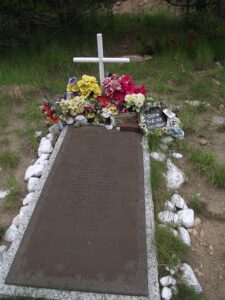
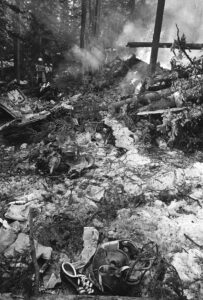 Continental Divide, which is, of course, quite high in altitude. Some witnesses who were located on higher mountainside locations, such as Loveland Pass at 11,990 feet, reported seeing it flying below them…into the mountains!! It is difficult for me to understand, how the pilots could no have seen this as a serious problem. Crash survivor Rick Stephens was a senior guard and stated in 2013, “…as we flew along over I-70, that there were old mines and old vehicles above us. I noticed we were quite a bit below the top of the mountains. I got up to go to the cockpit, which wasn’t unusual to do, and I could tell we were in trouble, looking out the window and seeing nothing but green in front of us.”
Continental Divide, which is, of course, quite high in altitude. Some witnesses who were located on higher mountainside locations, such as Loveland Pass at 11,990 feet, reported seeing it flying below them…into the mountains!! It is difficult for me to understand, how the pilots could no have seen this as a serious problem. Crash survivor Rick Stephens was a senior guard and stated in 2013, “…as we flew along over I-70, that there were old mines and old vehicles above us. I noticed we were quite a bit below the top of the mountains. I got up to go to the cockpit, which wasn’t unusual to do, and I could tell we were in trouble, looking out the window and seeing nothing but green in front of us.”
The other problem the plane had was that it was overloaded. Sadly, no one double checked the weight to make sure they were within safe limits. As the plane neared Loveland Pass, it flew up Clear Creek Valley, where it became trapped in a box canyon and was unable to climb above the mountain ridges surrounding it on three sides. It was also unable to complete a reversal turn away from the sharply rising terrain. At 1:14pm MDT, the “Gold” plane struck trees on the east slope of Mount Trelease, 1,600 feet below its summit, and crashed. The NTSB report stated that quite likely many of the passengers on board actually survived the initial impact. This was based on the testimony of survivors and rescuers. The load of fuel on board did not explode immediately. This allowed some of the survivors to escape the wreckage. Then, the passenger cabin exploded and trapped the people who were still alive. They had no way of escape. Of the 40 people on board, the death count at the scene was 29, which included 27 passengers, the captain, and flight attendant. One of the deceased passengers was an off-duty flight attendant who was assisting. Two of the initial 11 survivors later died of their injuries to bring the total dead to 31, 14 of whom were Wichita State football players. First to arrive at the crash scene were construction workers from the nearby Eisenhower Tunnel project and motorists on U.S. 6 (I-70). The first officer (company president) survived.
The National Transportation Safety Board report states that the weather did not play a role in the accident, but rather lists the probable cause to be that the pilot made improper decisions in-flight or in planning. The overloading probably played a part too, in that they couldn’t climb as fast as if they had not been overloaded. The report said that the cause was, “the intentional operation of the aircraft over a mountain valley route at an altitude from which the aircraft could neither climb over the obstructing terrain ahead, nor execute a successful course reversal, while other significant factors were the overloaded condition of the aircraft, the virtual absence of flight planning for the chosen route of flight from Denver to Logan, as well as a lack of understanding on the part of the crew of the performance capabilities and limitations of the aircraft, and the lack of operational management to monitor and appropriately control the actions of the flight crew.” It was a recipe for disaster. What I don’t understand is how the plane could have crashed less than a mile from an interstate highway that was straight and level in that area…the perfect place for an emergency landing. Why didn’t they use it?
Of course, the game was canceled, as were classes at Wichita State University. Utah State University’s football team held a memorial in the stadium where the game was to have been played…placing a wreath on the 50-yard line. Wichita State University officials and family members of the survivors were flown to Denver on an aircraft made available by Robert Docking, the Governor of Kansas. A memorial service was held on Monday, October 5th at Cessna Stadium in Wichita. The remaining members of the Wichita State team, with the NCAA and Missouri Valley Conference allowing freshman players to fill out the squad, decided to continue the 1970 season in honor of those lost. It was later designated the “Second Season.” Wichita State and Utah State had played in five of the previous six seasons, but never met again in football. Unable to fully recover from its loss, 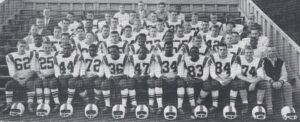 Wichita State discontinued varsity football after the 1986 season. Roadside memorial in Colorado on Interstate 70, milepost 217 Wichita State University built a memorial for those who died from the crash called Memorial ’70. Every year on October 2 at 9 a.m., a wreath is placed at this memorial. A roadside memorial plaque listing the names of the victims is located near the Colorado crash site, adjacent to westbound Interstate 70, at Dry Gulch at milepost 217, about two miles east of the Eisenhower Tunnel. A trail to the wreck site via Dry Gulch is 0.4 miles past the memorial off exit 216.
Wichita State discontinued varsity football after the 1986 season. Roadside memorial in Colorado on Interstate 70, milepost 217 Wichita State University built a memorial for those who died from the crash called Memorial ’70. Every year on October 2 at 9 a.m., a wreath is placed at this memorial. A roadside memorial plaque listing the names of the victims is located near the Colorado crash site, adjacent to westbound Interstate 70, at Dry Gulch at milepost 217, about two miles east of the Eisenhower Tunnel. A trail to the wreck site via Dry Gulch is 0.4 miles past the memorial off exit 216.
 These days, terrorist attacks are…if not common, expected to happen at some point. It’s the crazy world we now live in, but in 1910, it wasn’t quite so common. Nevertheless, on October 1, 1910, there was a massive explosion that destroyed the Los Angeles Times building in the LA’s downtown area. The bombing killed 21 people and injuring many more. Harrison Otis, who was the Los Angeles Times publisher and a bitter opponent of unions, believed that the bomb was directed at him. So, he hired William J Burns, the nation’s top private detective to find out who the culprits were. Otis, in addition to printing numerous editorials against unions, was the leader of the Merchants and Manufacturing Association, which was a powerful group of business owners, all of whom had extensive political connections.
These days, terrorist attacks are…if not common, expected to happen at some point. It’s the crazy world we now live in, but in 1910, it wasn’t quite so common. Nevertheless, on October 1, 1910, there was a massive explosion that destroyed the Los Angeles Times building in the LA’s downtown area. The bombing killed 21 people and injuring many more. Harrison Otis, who was the Los Angeles Times publisher and a bitter opponent of unions, believed that the bomb was directed at him. So, he hired William J Burns, the nation’s top private detective to find out who the culprits were. Otis, in addition to printing numerous editorials against unions, was the leader of the Merchants and Manufacturing Association, which was a powerful group of business owners, all of whom had extensive political connections.
The investigation led Burns to the Bridge and Structural Iron Workers Union and their treasurer, John J McNamara. Burns personally arrested McNamara and his brother in Indiana in April 1911, after Burns got a confession out of Ortie McManigal. It seems that McManigal had allegedly been the intermediary between 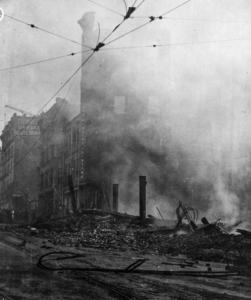 McNamara and two bomb experts. Burns had no legal authority to arrest anyone, but he did so, and managed to get the brothers to California, where they were scheduled to be prosecuted.
McNamara and two bomb experts. Burns had no legal authority to arrest anyone, but he did so, and managed to get the brothers to California, where they were scheduled to be prosecuted.
As is typical, and even expected, the Union members and left-wing supporters all rallied around the McNamara brothers. They raised a large defense fund, and union representatives pleaded with Clarence Darrow to take the case. Darrow was well known as the best defense attorney in America. He had already managed to get “Big Bill” Haywood, the union leader of the Industrial Workers of the World, off on murder charges in Idaho a few years earlier. After being offered $50,000, Darrow reluctantly took the case. Public opinion supported the McNamara brothers, but the investigation Darrow performed was quickly turning up evidence to prove that the brothers were actually guilty. To make matters worse, members of the defense team tried to bribe the jury, just to keep up with the prosecution’s own bribery tactics. In the end, Darrow worked out a deal with Otis and the prosecutors that the brothers would plead guilty to escape the death penalty, which they did. It was the best he could do for them.
Still, this plan was not acceptable to either side, and Darrow got caught in the middle. Darrow was soon 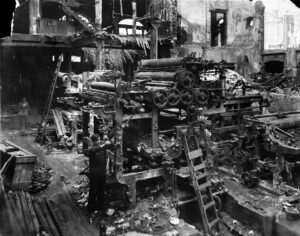 charged with bribery, and Otis arranged for Darrow’s prosecution. The union immediately deserted the great defense lawyer…not only did they refuse to pay his fee for the McNamara case, but they also refused to assist in his defense. Thankfully for Darrow, Earl Rogers, who was a notorious drunk, but also a brash, formidable, and effective Los Angeles attorney, took Darrow’s case. True to his reputation, Rogers managed to secure a mistrial for Darrow. Later, Darrow was acquitted after a second trial. Undaunted, Darrow went on to try even more distinguished cases, including the Leopold and Loeb murder trial and the Scopes evolution trial. Still, I doubt if any trial stood out in his memory quite as much as the trial that almost cost him his freedom.
charged with bribery, and Otis arranged for Darrow’s prosecution. The union immediately deserted the great defense lawyer…not only did they refuse to pay his fee for the McNamara case, but they also refused to assist in his defense. Thankfully for Darrow, Earl Rogers, who was a notorious drunk, but also a brash, formidable, and effective Los Angeles attorney, took Darrow’s case. True to his reputation, Rogers managed to secure a mistrial for Darrow. Later, Darrow was acquitted after a second trial. Undaunted, Darrow went on to try even more distinguished cases, including the Leopold and Loeb murder trial and the Scopes evolution trial. Still, I doubt if any trial stood out in his memory quite as much as the trial that almost cost him his freedom.
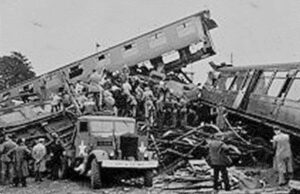 Trainwrecks can obviously happen at any time, but I think the worst time would be in the middle of the night, when the people onboard…other than the crew…are sleeping, or at the very least, dozing. There is nothing worse than being awakened to impending disaster. On September 30, 1945, a train was on its way from Perth to London Euston. The train was the 15-coach overnight Perth to London Euston express hauled by LMS Royal Scot Class 4-6-0 No 6157 The Royal Artilleryman. Part of the journey was to include a diversion, due to engineering work being done on the Watford tunnel. The train was scheduled to switch from the fast to the slow lines at Bourne End, near Hemel Hempstead. For reason unknown, the engineer failed to slow the train down in response to cautionary signals on the approach to the diversion. As a result, the train entered a 15-mile-per-hour turnout at nearly 60 miles per hour.
Trainwrecks can obviously happen at any time, but I think the worst time would be in the middle of the night, when the people onboard…other than the crew…are sleeping, or at the very least, dozing. There is nothing worse than being awakened to impending disaster. On September 30, 1945, a train was on its way from Perth to London Euston. The train was the 15-coach overnight Perth to London Euston express hauled by LMS Royal Scot Class 4-6-0 No 6157 The Royal Artilleryman. Part of the journey was to include a diversion, due to engineering work being done on the Watford tunnel. The train was scheduled to switch from the fast to the slow lines at Bourne End, near Hemel Hempstead. For reason unknown, the engineer failed to slow the train down in response to cautionary signals on the approach to the diversion. As a result, the train entered a 15-mile-per-hour turnout at nearly 60 miles per hour.
They were going far too fast, and the train couldn’t maintain its position on the tracks. The engine and the first six cars overturned and fell down an embankment into a field. When the derailment was over, only the last 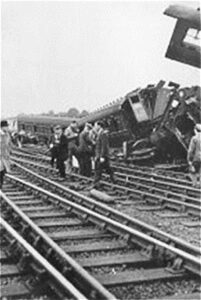 three cars remained on the rails, 43 people were dead, and 65 people were injured. The investigation determined that the cause was driver error, possibly compounded by ambiguous signaling regulations. The fact that the engineer was very experienced with a reputation for being conscientious and had read the notice about the diversion before leaving Crewe, makes the accident that much more odd. It is thought that he may not have appreciated its significance of the diversion. He had worked 26 days consecutively due to staff shortages following the war, so it was possible that he had either momentarily dozed off or that fatigue caused him to momentarily go into “autopilot” mode. Unfortunately, this particular line had not yet been fitted with the Automatic Warning System, which probably could have prevented the accident.
three cars remained on the rails, 43 people were dead, and 65 people were injured. The investigation determined that the cause was driver error, possibly compounded by ambiguous signaling regulations. The fact that the engineer was very experienced with a reputation for being conscientious and had read the notice about the diversion before leaving Crewe, makes the accident that much more odd. It is thought that he may not have appreciated its significance of the diversion. He had worked 26 days consecutively due to staff shortages following the war, so it was possible that he had either momentarily dozed off or that fatigue caused him to momentarily go into “autopilot” mode. Unfortunately, this particular line had not yet been fitted with the Automatic Warning System, which probably could have prevented the accident.
As a train comes up to turns or track changes, the railroad provides advance warning of the turnout by “a color light distant signal showing double yellow, an outer home signal showing green, and two ‘splitting’ semaphore inner homes side by side showing which route was set. The double yellow aspect could have an important extra meaning under Rule 35b(ii), “In some cases, color light signals will exhibit two yellow lights. This indication means – Pass next signal at restricted speed, and if applicable to a junction may denote that the points are set for a diverging route over which the speed restriction shown in the appendix applies.” Because this arrangement is ambiguous, the inspector pointed out that it evidently did not alert the engineer to the 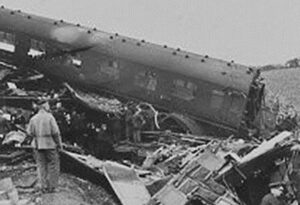 approaching low speed turnout. It was unclear why he failed to notice the diverging route indication of the splitting inner homes. It’s possible that the low sun shining directly in his face would have made observation tiring, but the signals were still clearly visible.
approaching low speed turnout. It was unclear why he failed to notice the diverging route indication of the splitting inner homes. It’s possible that the low sun shining directly in his face would have made observation tiring, but the signals were still clearly visible.
The accident was first reported by a pilot who had just taken off from Bovingdon Aerodrome. As he took off, he could see the accident, so he immediately notified the railway authorities via the Bovingdon Control tower. Airfield staff also helped significantly with assistance after the crash. With the death toll at 43, this became Britain’s joint seventh worst rail disaster in terms of death toll.
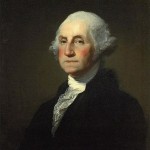 George Washington was not just our first president, but he was also an incredibly intelligent man. Normally, when George Washington spoke, people listened. Maybe his leadership was a big part of what made our system of government work so well, but there was one thing that everyone decided to ignore…his warnings about political parties. George Washington was against them, you see. He wasn’t just against one side of the political party system. He was against having political parties at all. He was so adamantly against them, that he remained nonpartisan throughout his entire presidency.
George Washington was not just our first president, but he was also an incredibly intelligent man. Normally, when George Washington spoke, people listened. Maybe his leadership was a big part of what made our system of government work so well, but there was one thing that everyone decided to ignore…his warnings about political parties. George Washington was against them, you see. He wasn’t just against one side of the political party system. He was against having political parties at all. He was so adamantly against them, that he remained nonpartisan throughout his entire presidency.
In his farewell address, President Washington said the following about partisan politics, “It serves always to distract the public councils and enfeeble the public administration. It agitates the community with ill-founded jealousies and false alarms, kindles the animosity of one part against another, foments occasionally riot and insurrection. It opens  the door to foreign influence and corruption, which finds a facilitated access to the government itself through the channels of party passions. Thus, the policy and the will of one country are subjected to the policy and will of another.” Any of this sound familiar? Of course, it does. It is exactly what we have going on today.
the door to foreign influence and corruption, which finds a facilitated access to the government itself through the channels of party passions. Thus, the policy and the will of one country are subjected to the policy and will of another.” Any of this sound familiar? Of course, it does. It is exactly what we have going on today.
I agree with President Washington, who worried that political parties would become too powerful, rob the people of their control over their own government, and distract everyone from what they should really be focusing on. In today’s political arena, that is exactly what is going on. People are being indited as a way of weaponizing politics. If someone doesn’t agree with the other party, or can’t be controlled, they are very likely to be politically ostracized and attacked. Since George Washington spoke those words, 250 years have passed, and there are people saying that they don’t trust either political party. I am one of those. I suppose some 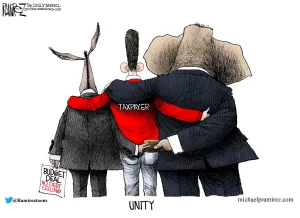 people would wonder how we would elect our leaders. To them, I say, “How about electing them on their merits!!” There are people out there who will simply vote for the party they are affiliated with, no matter what their candidate stands for. They vote the way they vote, simply because the candidate they choose is from their party. What a horrible mistake that is. Isn’t it time that we find out what our candidates really stand for, and then vote our conscience? Isn’t it time we hold our politicians accountable for their actions? I think it is, but then we would have to find a way to get the correct information, and we already know that we can’t trust the media!! But that is another story.
people would wonder how we would elect our leaders. To them, I say, “How about electing them on their merits!!” There are people out there who will simply vote for the party they are affiliated with, no matter what their candidate stands for. They vote the way they vote, simply because the candidate they choose is from their party. What a horrible mistake that is. Isn’t it time that we find out what our candidates really stand for, and then vote our conscience? Isn’t it time we hold our politicians accountable for their actions? I think it is, but then we would have to find a way to get the correct information, and we already know that we can’t trust the media!! But that is another story.
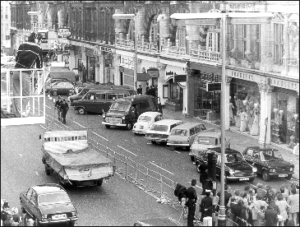 Often when a robbery goes wrong, the would-be robbers decide that the best way out of the situation is to take hostages. The hope is to negotiate a way out of their pending imprisonment. Most hostage takings or sieges last a few hours but on September 28, 1975, The Spaghetti House siege began, and it continued until October 3, 1975. The Spaghetti House was a restaurant in Knightsbridge, London, and when the robbery went wrong, the police were on the scene so quickly that the robbers couldn’t get away. Seeing that they were trapped, the three robbers took the staff down into a storeroom and barricaded themselves in. The three robbers had been involved in black liberation organizations and tried to set the robbery as being politically motivated, thinking that a political standoff might have a better chance of success. The police did not believe them, however, and they stated that this was no more than a criminal act. Finally, they decided that the political ploy was not going to work, so the robbers released all the hostages unharmed after six days. I can’t say for sure that this was the longest robbery siege in history, but if it wasn’t, it ranked right up there. Finally, two of the gunmen gave themselves up, while the ringleader, Franklin Davies, shot himself in the stomach. He survived, and all three were later imprisoned, as were two accomplices. To keep tabs on the situation during the siege, the police used fiber optic camera technology, giving them live surveillance. They monitored the actions and conversations of the gunmen from the audio and visual output. They brought in a forensic psychiatrist to watch the feed and advise the police on the state of the men’s minds, and how to best manage the ongoing negotiations.
Often when a robbery goes wrong, the would-be robbers decide that the best way out of the situation is to take hostages. The hope is to negotiate a way out of their pending imprisonment. Most hostage takings or sieges last a few hours but on September 28, 1975, The Spaghetti House siege began, and it continued until October 3, 1975. The Spaghetti House was a restaurant in Knightsbridge, London, and when the robbery went wrong, the police were on the scene so quickly that the robbers couldn’t get away. Seeing that they were trapped, the three robbers took the staff down into a storeroom and barricaded themselves in. The three robbers had been involved in black liberation organizations and tried to set the robbery as being politically motivated, thinking that a political standoff might have a better chance of success. The police did not believe them, however, and they stated that this was no more than a criminal act. Finally, they decided that the political ploy was not going to work, so the robbers released all the hostages unharmed after six days. I can’t say for sure that this was the longest robbery siege in history, but if it wasn’t, it ranked right up there. Finally, two of the gunmen gave themselves up, while the ringleader, Franklin Davies, shot himself in the stomach. He survived, and all three were later imprisoned, as were two accomplices. To keep tabs on the situation during the siege, the police used fiber optic camera technology, giving them live surveillance. They monitored the actions and conversations of the gunmen from the audio and visual output. They brought in a forensic psychiatrist to watch the feed and advise the police on the state of the men’s minds, and how to best manage the ongoing negotiations.
There were a number of things that potentially led up to the robbery, not that these things were in any way a good excuse. Post-World War II Britain had a shortage of labor. Due to that shortage, the British decided to bring in workers from the British Empire and Commonwealth countries. These people came from poverty areas, 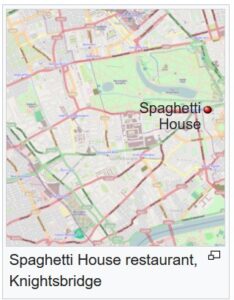 and while they were placed in low-pay, low-skill employment, which forced them to live in poor housing, it probably wasn’t much different than what they came from. Nevertheless, economic circumstances and what were seen by many in the black communities as racist policies applied by the British government, just like in other nations. This led to a rise in militancy, particularly among the West Indian community. The people grew angry, and their feelings were exacerbated by police harassment and discrimination in the education sector. The director of the Institute of Race Relations in the mid-1970s, Ambalavaner Sivanandan said that while the first generation had become partly assimilated into British society, the second generation were increasingly rebellious. These robbers were a part of that second generation.
and while they were placed in low-pay, low-skill employment, which forced them to live in poor housing, it probably wasn’t much different than what they came from. Nevertheless, economic circumstances and what were seen by many in the black communities as racist policies applied by the British government, just like in other nations. This led to a rise in militancy, particularly among the West Indian community. The people grew angry, and their feelings were exacerbated by police harassment and discrimination in the education sector. The director of the Institute of Race Relations in the mid-1970s, Ambalavaner Sivanandan said that while the first generation had become partly assimilated into British society, the second generation were increasingly rebellious. These robbers were a part of that second generation.
The ringleader, Franklin Davies was a 28-year-old Nigerian student who had previously served time in prison for armed robbery. The two men with him were Wesley Dick (later known as Shujaa Moshesh), who was a 24-year-old West Indian; and Anthony “Bonsu” Munroe, a 22-year-old Guyanese. The men were all involved in black liberation organizations at one time or another. Davies had tried to enlist in the guerrilla armies of Zimbabwe African National Union and FRELIMO in Africa. While Munroe had links to the Black Power movement. Dick was an attendee at meetings of the Black Panthers, the Black Liberation Front (BLF), the Fasimba, and the Black Unity and Freedom Party. He regularly visited the offices of the Institute of Race Relations to volunteer and access their library. Sivanandan and the historian Rob Waters identify that the three men were attempting to obtain money to “finance black supplementary schools and support African liberation struggles.”
By the mid-1970s the branch managers started a weekly tradition of closing the London-based Spaghetti House restaurant chain to meet at the company’s Knightsbridge branch. During that time, the outlet would be closed, but managers would deposit the week’s takings there, before it was paid into a night safe at a nearby bank. Of course, that was a well-known fact. So, at approximately 1:30am on Sunday, September 28, 1975, Davies, Moshesh, and Munroe entered the Knightsbridge branch of the Spaghetti House. One carried a sawed-off shotgun, and the others had handguns. The three men burst in and demanded the week’s takings from the chain, which was between £11,000 and £13,000. The restaurant was dimly lit, and it gave the staff a chance to 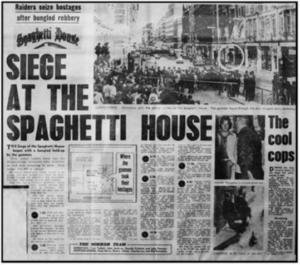 hide the briefcases of money under the tables. Now infuriated, the three men forced the staff down into the back, but the company’s general manager managed to escape out the rear fire escape.
hide the briefcases of money under the tables. Now infuriated, the three men forced the staff down into the back, but the company’s general manager managed to escape out the rear fire escape.
He quickly called the Metropolitan Police, who were at the scene within minutes. The getaway driver, Samuel Addison, realized that the plan was going wrong, so he decided that it was every man for himself, and drove off in a stolen Ford. The police entered the ground floor, so Davies and his colleagues forced the staff into a rear storeroom measuring 14 by 10 feet, locked the door, barricaded it with beer kegs. They began shouting at the police that they would shoot if they approached the door. The police surrounded the building, and the siege began. It would finally end on October 3, 1975, with the surrender of the robbers, and later the location and arrest of the two accomplices.
.

 My granddaughter-in-law, Athena Petersen has had a very busy year. Since her last birthday, she and my grandson, Josh Petersen had their first child, Justin Petersen, who was born on October 14, 2022. Then, they got married on June 24, 2023, and to finish the year in style, just nine days ago, they had their second child, Axel Petersen…for a set of Irish Twins. Irish Twins are siblings who were born within a twelve-month period. All this made for a very busy year, with all this taking place between two birthdays. Most of us would be hard pressed to get a third of this done in one year.
My granddaughter-in-law, Athena Petersen has had a very busy year. Since her last birthday, she and my grandson, Josh Petersen had their first child, Justin Petersen, who was born on October 14, 2022. Then, they got married on June 24, 2023, and to finish the year in style, just nine days ago, they had their second child, Axel Petersen…for a set of Irish Twins. Irish Twins are siblings who were born within a twelve-month period. All this made for a very busy year, with all this taking place between two birthdays. Most of us would be hard pressed to get a third of this done in one year.
Having Irish Twins is such a cool thing. I know, because I am also a mom of Irish Twins. As Athena and Josh with find out, the boys will have a period of time where they will be the same age. Sometimes they think that it’s cool, and sometimes not so much. It really depends on how old the kids 
 are. As they get older, it will become cool. They will also find out that they will have three years of diapers instead of four, although they will likely use the same number of diapers to do it. Having Irish Twins can be a lot of work…at first. Often the older child can’t walk when the younger one is born. My daughter didn’t walk until she was thirteen months old, so I had two month of carrying both kids. As for Athena and Josh, Justin is beginning to walk now, so that will be a little bit easier for them. Even with Justin walking, the first year with Irish Twins is a blessed, wild ride.
are. As they get older, it will become cool. They will also find out that they will have three years of diapers instead of four, although they will likely use the same number of diapers to do it. Having Irish Twins can be a lot of work…at first. Often the older child can’t walk when the younger one is born. My daughter didn’t walk until she was thirteen months old, so I had two month of carrying both kids. As for Athena and Josh, Justin is beginning to walk now, so that will be a little bit easier for them. Even with Justin walking, the first year with Irish Twins is a blessed, wild ride.

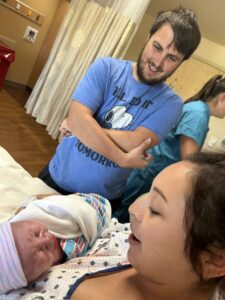 Athena is a sweet girl and a wonderful mom, handling her older son with ease, as I know she will the two boys. She is a natural boy mom, having been auntie to a number of nephews, as some nieces too. Children love her, and she is a kid at heart, who can totally relate to children, making her a natural mom. She and Josh are so happy together, and we couldn’t have asked for a better wife for him. They are perfect for each other, and they have known each other for a long time. I think they will always be best friends, and that is the most important part of being husband and wife. If your husband is your best friend, your marriage will always be filled with comradery. That is my hope for Athena and Josh. It is God’s best for a marriage. Today is Athena’s birthday. Happy birthday Athena!! Have a great day!! We love you!!
Athena is a sweet girl and a wonderful mom, handling her older son with ease, as I know she will the two boys. She is a natural boy mom, having been auntie to a number of nephews, as some nieces too. Children love her, and she is a kid at heart, who can totally relate to children, making her a natural mom. She and Josh are so happy together, and we couldn’t have asked for a better wife for him. They are perfect for each other, and they have known each other for a long time. I think they will always be best friends, and that is the most important part of being husband and wife. If your husband is your best friend, your marriage will always be filled with comradery. That is my hope for Athena and Josh. It is God’s best for a marriage. Today is Athena’s birthday. Happy birthday Athena!! Have a great day!! We love you!!
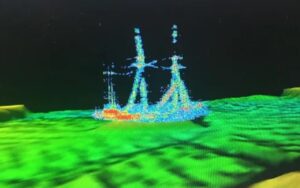 Imagine finding a ship, sitting fully intact on the bottom of a lake, as if the ship was built there. That is exactly what happened in 2019, when researchers from the marine sanctuary partnered with Ocean Exploration Trust, the group known for finding the Titanic in 1985, and embarked on a mapping expedition. The mission was sparked by the discovery of SS Ohio on the bottom of Lake Huron, in an area known as Shipwreck Alley. They knew that SS Ohio had gone down in the area following a collision with the schooner barge, Ironton, so it followed that if they had found SS Ohio, the Ironton must be nearby. Still, while they expected to find the wreck of the Ironton, what they actually found was…stunning!!
Imagine finding a ship, sitting fully intact on the bottom of a lake, as if the ship was built there. That is exactly what happened in 2019, when researchers from the marine sanctuary partnered with Ocean Exploration Trust, the group known for finding the Titanic in 1985, and embarked on a mapping expedition. The mission was sparked by the discovery of SS Ohio on the bottom of Lake Huron, in an area known as Shipwreck Alley. They knew that SS Ohio had gone down in the area following a collision with the schooner barge, Ironton, so it followed that if they had found SS Ohio, the Ironton must be nearby. Still, while they expected to find the wreck of the Ironton, what they actually found was…stunning!!
Ironton and SS Ohio, both sank in September 1894, following a collision that claimed the lives of five of the ship’s crew. The facts of the loss were only known because if the first-hand accounts of the wreck’s two survivors. Were it not for these survivors, the location might never have been known. Still, the wrecks sat on the lake floor for over a hundred years, waiting for a time in history when we had the technology and equipment necessary to actually go down and find the wrecks. What everyone who sailed the Great Lakes knows is that they are deep, and can be treacherous, especially in the winter…and “Shipwreck Alley” is an area of Lake Huron well known for its treacherous waters that have claimed the lives of many sailors.
On that fateful September day in 1894, the 190-foot steamer Charles J Kershaw departed Ashtabula, Ohio, on Lake Erie. She was towing the schooner barges Ironton and Moonlight. The vessels sailed empty, and they were destined for Marquette, Michigan, on Lake Superior. Things were going well, until at 12:30am on Sept. 26, while sailing north across Lake Huron under clear skies, Kershaw’s engine failed, leaving the ship without 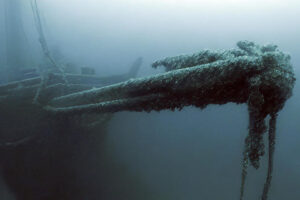 power. This was the beginning of disaster. They might have been ok, had it not been for the notorious winds in “Shipwreck Alley.” The Kershaw was a few miles north of the Presque Isle Lighthouse, when a strong south wind pushed Moonlight and Ironton toward the disabled steamer. The crew attempted to avoid the impending entanglement and a possible collision. Moonlight’s crew cut Ironton’s tow line, detaching the steamer from the schooner barges. Still, the winds were not letting up, and now the ship and the barges were at their mercy.
power. This was the beginning of disaster. They might have been ok, had it not been for the notorious winds in “Shipwreck Alley.” The Kershaw was a few miles north of the Presque Isle Lighthouse, when a strong south wind pushed Moonlight and Ironton toward the disabled steamer. The crew attempted to avoid the impending entanglement and a possible collision. Moonlight’s crew cut Ironton’s tow line, detaching the steamer from the schooner barges. Still, the winds were not letting up, and now the ship and the barges were at their mercy.
When Ironton was cut loose, the crew suddenly found themselves adrift in the dark fighting the wind and praying that they didn’t hit anything. They fought with all that was in them to regain control of the ship. Under the direction of Captain Peter Girard, they fired up the vessel’s auxiliary steam engine to help set the struggling ship’s sails, but even with their best efforts, Ironton, being propelled by the wind from astern, veered off course into the path of the southbound steamer Ohio. The Ohio, a 203-foot wooden freighter was enroute to Ogdensburg, New York, from Duluth, Minnesota, loaded with 1,000 tons of grain.
The night was dark, so by the time Ironton’s crew spotted the approaching Ohio through the darkness, it was too late to avoid a head-on collision with the steamer. William Wooley of Cleveland, Ohio, a surviving crew member of Ironton, said, “At this time we sighted a steamer on our starboard bow. She came up across our bow and we struck her on the quarter about aft of the boiler house. A light was lowered over our bow, and we saw a hole in our port bow and our stem splintered.”
SS Ohio was found upright in 2017, over 122 years after her sinking in over 200 feet of water off Presque Isle, 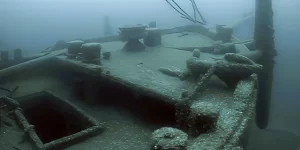 Michigan. It was at this point that the search began for Ironton, which was expected to be nearby. In March, 2023, it was announced that Ironton had been located in 2019. The searchers waited to announce the finding, while they explored the vessel, hoping to discover how she could be in such pristine condition. The cold freshwater of the lake has kept the Ironton intact. According to Michigan Radio’s Jodi Westrick, an anchor is still connected to the ship, as are its three masts. In addition, a lifeboat remains tied to the vessel, a chilling reminder of how the ship’s demise played out on a harrowing night in 1894. It is as if time stood still for 1894 to the present day. Amazing!!
Michigan. It was at this point that the search began for Ironton, which was expected to be nearby. In March, 2023, it was announced that Ironton had been located in 2019. The searchers waited to announce the finding, while they explored the vessel, hoping to discover how she could be in such pristine condition. The cold freshwater of the lake has kept the Ironton intact. According to Michigan Radio’s Jodi Westrick, an anchor is still connected to the ship, as are its three masts. In addition, a lifeboat remains tied to the vessel, a chilling reminder of how the ship’s demise played out on a harrowing night in 1894. It is as if time stood still for 1894 to the present day. Amazing!!

 Life is changing drastically for my grandniece, Jolene Thompson. Recently, her family moved from Riverton, Wyoming to Shoshoni, Wyoming, and they now live on a farm. Jolene, who is very much an outdoor girl now gets to take care of animals, and that suits her just fine. With the move came a new school, and Jolene is really thriving there. Living in Shoshoni also puts her in the same town as her grandparents, and that closeness is going to be awesome. Jolene is such a social girl, so she has already made lots of friends already. Not everyone can just pick up and start over in a whole new place and immediately have a ton of friends, but Jolene can. Jolene has an amazing smile, and it draws people to her. She is truly a friend magnet. Not only does Jolene have lots of friends, but
Life is changing drastically for my grandniece, Jolene Thompson. Recently, her family moved from Riverton, Wyoming to Shoshoni, Wyoming, and they now live on a farm. Jolene, who is very much an outdoor girl now gets to take care of animals, and that suits her just fine. With the move came a new school, and Jolene is really thriving there. Living in Shoshoni also puts her in the same town as her grandparents, and that closeness is going to be awesome. Jolene is such a social girl, so she has already made lots of friends already. Not everyone can just pick up and start over in a whole new place and immediately have a ton of friends, but Jolene can. Jolene has an amazing smile, and it draws people to her. She is truly a friend magnet. Not only does Jolene have lots of friends, but 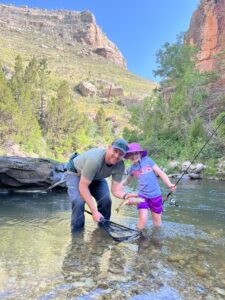
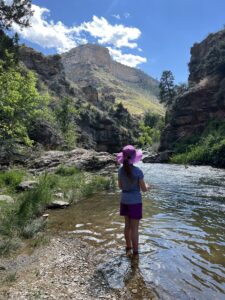 she is such a leader. When she makes friends, she is the leader of the pack too. She isn’t a girl who gets into trouble, so having her be the leader of the pack is definitely a great thing, and her friends’ parents love it.
she is such a leader. When she makes friends, she is the leader of the pack too. She isn’t a girl who gets into trouble, so having her be the leader of the pack is definitely a great thing, and her friends’ parents love it.
Jolene, who goes by Jo as much or more than Jolene, loves to fish. Her dad, Tim Thompson also loves to fish, hunt, go camping, and every other kind of outdoor activity, so it stands to reason that his daughter would also love these things. The family threw a great big birthday bash for Jo, and of course, the theme of the party was…you guessed it, fishing. Jo is her daddy’s mini-me, and if her daddy likes something, so does she. And to top it off, she is very good at all the outdoor sport things her daddy likes. She loves to catch bugs, hunt, fish, and really any of the outdoor things. And of course, 
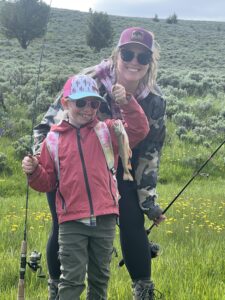 Jo can totally keep up with all the boys, but don’t let that fool you, because she is very much a girly girl…just not a wimpy girl. In fact, don’t call her a fisherman, because she is a fisher…GIRL!!
Jo can totally keep up with all the boys, but don’t let that fool you, because she is very much a girly girl…just not a wimpy girl. In fact, don’t call her a fisherman, because she is a fisher…GIRL!!
While Jo can and does “keep up with” the boys, she wants to dress and look like a girl! In fact, my niece, Kellie Hadlock (who is Tim’s girlfriend) says, “I dare you to try putting her in some Carhart overalls for fishing, lol!!” Outside of all that she is the toughest, sweetest, funniest, and smartest little girl!! Tim and Kellie are so incredibly proud of her!! Jo is very down to earth, but also very bubbly and fun, and our whole family feels blessed to know her. Today is Jo’s 8th birthday. Happy birthday Jo!! Have a great day!! We love you!!
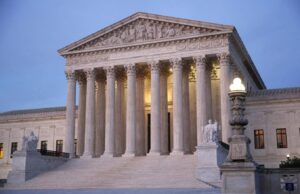 Our government is made up of three branches. The three branches of the United States government are the legislative, executive, and judicial branches. According to the doctrine of separation of powers, the United States Constitution distributed the power of the federal government among these three branches and built a system of checks and balances to ensure that no one branch could become too powerful. This is a long-standing system that has served the United States well, as long as it isn’t being abused.
Our government is made up of three branches. The three branches of the United States government are the legislative, executive, and judicial branches. According to the doctrine of separation of powers, the United States Constitution distributed the power of the federal government among these three branches and built a system of checks and balances to ensure that no one branch could become too powerful. This is a long-standing system that has served the United States well, as long as it isn’t being abused.
The judicial branch came into being when The Judiciary Act of 1789 was passed by Congress and signed by President George Washington, establishing the Supreme Court of the United States as a tribunal made up of six justices who were to serve on the court until death or retirement. Sometimes I’m not sure how I feel about the “until death or retirement” part, but I’m sure they had their reasons. To me, there are some justices, like some members of congress who far outstay their welcome. Nevertheless, on that day, President Washington nominated John Jay to preside as chief justice. He further named John Rutledge, William Cushing, John Blair, Robert Harrison, and James Wilson to be associate justices. On September 26, all six appointments were confirmed by the US Senate, and with that, we had our first Supreme Court. 
The US Supreme Court was established by Article 3 of the US Constitution. Article 3 granted the Supreme Court ultimate jurisdiction over all laws, especially those in which their constitutionality was at issue. In addition, the high court was also designated to oversee cases concerning treaties of the United States, foreign diplomats, admiralty practice, and maritime jurisdiction. The first session of the US Supreme Court was held on February 1, 1790, in New York City’s Royal Exchange Building.
The US Supreme Court quickly grew into the most important judicial body in the world in terms of its central place in the American political order. The Constitution allows Congress to set the size of the court…another part of the system that I don’t think I agree with, simply because a corrupt congress could take advantage of that ability by stacking the courts to rule in their favor. I’m sure that Washington and the founding fathers planned for the justices to be honest and trustworthy. I’m sure too, that the fact that they were Supreme Courts justices for life or until retirement, was planned to allow them to make their rulings without fear of being fired. Of course, there is more that one way to get a justice removed, because dead can come by more than one means, including murder. And justices could be threatened or have 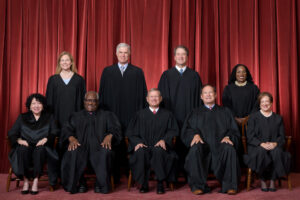 their families threatened, causing them to vote in a specific way. In a perfect world, justices would act according to the Constitution, and vote their conscience, bringing about an honest and fair ruling, but that is not always the case…sadly. The number of justices varied during the 19th century before stabilizing in 1869 at nine. While this number can be changed at any time by Congress, so far, it has not, and I believe that the Constitution should be amended to make the number nine, permanent. In times of constitutional crisis, the Supreme Court has always played a definitive role in resolving, for better or worse, the great issues of the time, and the number nine has worked well. It should not be changed.
their families threatened, causing them to vote in a specific way. In a perfect world, justices would act according to the Constitution, and vote their conscience, bringing about an honest and fair ruling, but that is not always the case…sadly. The number of justices varied during the 19th century before stabilizing in 1869 at nine. While this number can be changed at any time by Congress, so far, it has not, and I believe that the Constitution should be amended to make the number nine, permanent. In times of constitutional crisis, the Supreme Court has always played a definitive role in resolving, for better or worse, the great issues of the time, and the number nine has worked well. It should not be changed.

